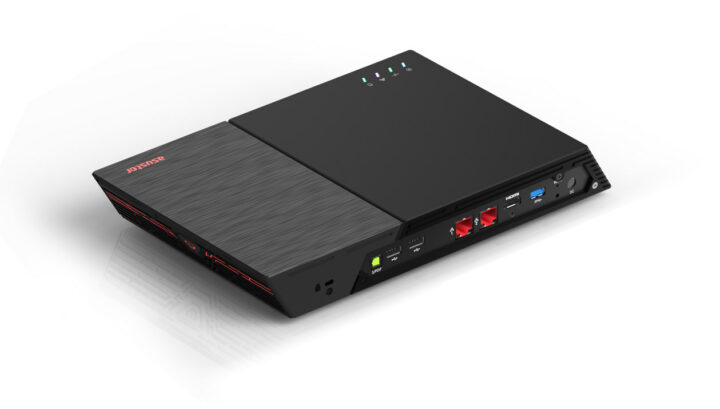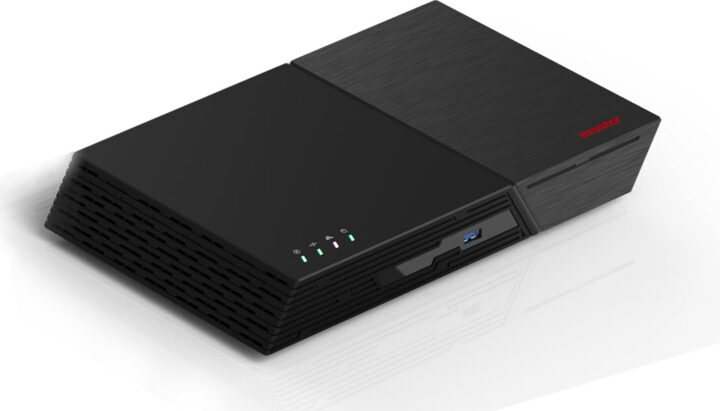ASUSTOR FLASHSTOR 6 and FLASHSTOR 12 are network access storage (NAS) devices powered by a quad-core Intel Celeron N5095 Jasper Lake processor and designed for respectively 4K audio and video content consumption for the former and 4K video editing for the latter.
Both models come with 4 GB of DDR4-2933, two USB 3.2 Gen 2×1 ports, and HDMI 2.0b video output, but the FLASHSTOR 6 supports up to 6 M.2 NVMe SSDs and 2.5GbE networking, while the FLASHSTOR 12 can take up to 12 M.2 NVMe SSDs and handles 10GbE networking.
ASUSTOR FLASHSTOR specifications:
- SoC – Intel Celeron N5105 quad-core Jasper Lake processor @ 2.0 GHz / 2.9 GHz (Turbo)
- System Memory – 4GB SO-DIMM DDR4, expandable up to 16GB via 2x SO-DIMM slots
- Storage
- 8GB eMMC flash for the OS
- FLASHSTOR 6 (FS6706T) – 6x M.2 2280 NVMe drive slots, up to 14x drives with AS6004U expansion unit for HDD/SSD
- FLASHSTOR 6 (FS6712X) – 12x M.2 2280 NVMe drive slots, up to 20x drives with AS6004U expansion unit for HDD/SSD
- Networking
- FLASHSTOR 6 (FS6706T) – 2x 2.5GbE RJ45 ports (2.5G/1G/100M)
- FLASHSTOR 6 (FS6712X) – 1x 10GbE port (10G/5G/2.5G/1G/100M)
- Video and audio outputs – 1x HDMI 2.0b, 1x S/PDIF
- USB – 2x USB 3.2 Gen 2×1 (10 Gbps), 2 x USB 2.0
- Misc – 80mm system fan (Noise Level: 18.7dB)
- Power Supply – FS6706T: 65W; FS6712X: 90W
- Power Consumption
- Operation – FS6706T: 18.2W; FS6712X: 26W
- Sleep mode – 0.83W
- Dimensions – 308.26 x 193 x 48.3 mm
- Weight – About 1.35 kg
- Temperature Range – 0°C~40°C
- Humidity – 5% to 95% RH
- Certifications – FCC, CE, VCCI, BSMI, C-TICK, KCC, BIS, CCC, UKCA
The NAS devices support a wide range of software features such as the ASUSTOR Portal (HDMI Local Output), Cloud Backup Center, DataSync Center for Google Drive, OneDrive, Dropbox, etc.. sync, LooksGood smart video manager with transcoding capabilities, and many others. The internal drives are formatted with EXT4 or Btrfs, while the external drives support FAT32, NTFS, EXT3, EXT4, HFS+, exFAT, or Btrfs. Supported operating systems include Windows XP to 11, Windows Server 2003 to 2022, macOS, UNIX, Linux, and BSD.
It’s not the first time we write about NAS with NVMe SSDs, as QNAP launched the TBS-464 ultra-thin NAS with support for up to four M.2 NVMe SSDs and 2.5GbE networking in 2021, and followed up with the TBS-574X NAS taking hot-swappable E1.S SSDs last year.
The FLASHSTOR 6 and 12 can be purchased on Amazon for $499.00 and $799.00 respectively. Further details may be found on the product page.
Thanks to TLS for the tip.

Jean-Luc started CNX Software in 2010 as a part-time endeavor, before quitting his job as a software engineering manager, and starting to write daily news, and reviews full time later in 2011.
Support CNX Software! Donate via cryptocurrencies, become a Patron on Patreon, or purchase goods on Amazon or Aliexpress






